План-конспект уроку в 10 кл. з теми "Національна кухня"
План конспект підсумкового уроку за темою "Національна кухня".Це нестандартний урок -демонстрація , де використані інтерактивні методи роботи та інноваційні технології.
Урок – демонстрація з англійської мови в 10 класі.
Тема “Національна кухня”
(урок узагальнення і систематизації знань)
Aim:
- ознайомити учнів з національними кухнями світу;
- навчати систематизувати і узагальнювати інформацію;
- повторити і закріпити лексичний матеріал теми;
- закріпити граматичний матеріал: 2-d Conditional;
- продовжувати формувати навички монологічного мовлення;
- тренувати учнів в аудіюванні і читанні;
- розвивати комунікативні навички учнів;
- виховувати дбайливе ставлення до їжі як до складової свого здоров’я.
Equipments: computer, projector, screen (interactive teacher’s place), O.Karpiuk “English 10”, CD-player, cards.
I
Greeting
T: Hello, my dear children and our guests. I am glad to see you. So let me start our lesson.
Aim
T: Today we are going to talk about national cuisine and do some grammar exercises. So look at the screen where you can read the topic of our lesson “ National Cuisine. The Second Conditional.”
I. Warming up
T: People can not live without food. But we should remember that
We eat to live, but we do not live to eat.
1. So, tell me please:
What kinds of food do you know?
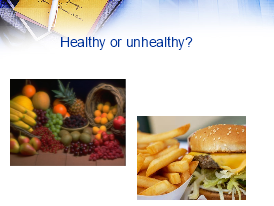
Why do people eat fast food or junk food?
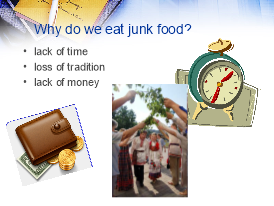
Why should people eat healthy food?

What can you say about junk food?
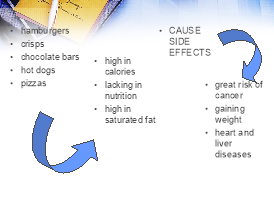
So, what food do you prefer?
2. How many words can you find in this chain of letters? Well, there are 7 words there. Can you find them?
- Eatjuiceorangepotatoberrylunchpepper
- Drinktomatosuppercucumbersaltsausageplate
3. “Jumble sentences”
- People, live, cannot, food, without.
- Animals, live, fish, birds, cannot, without, food.
- Bread, sugar, cheese, you, give, energy.
- Meat, fish, milk, you, help, to grow.
- Vegetables, eggs, your, bones, make, teeth, strong.
- Fruit, vegetables, got, have, a lot of, vitamins.
- Vitamins, important, are, for, body, our.
- Eat, food, the right.
II
Vocabulary Practice
1 ) T: Look at the screen
Your task is to complete the sentences with the adjectives from the box:
fresh, frozen, home – made, low – fat, raw, spicy, sweet, takeaway.
1 Food which is kept very cold is …
2 These eggs are …, I bought them today.
3 I like my mum’s cooking. … food is always the best.
4 This tea is very …. You have put too much sugar in it.
5 Indian food like curry is very ….
6 … food is food you buy at a restaurant and take home to eat.
7 Sushi is made with … fish.
8 People on a diet often try to eat … food.
2 ) T: You know that almost every country has its own cuisine and what is more some popular dishes are associated with this or that national cuisine. We are to remember such dishes.
Look at the screen. Your task is to complete the sentences.
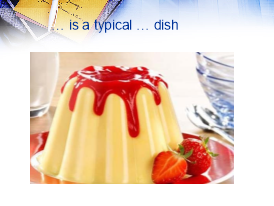
Pudding is a typical English dish.
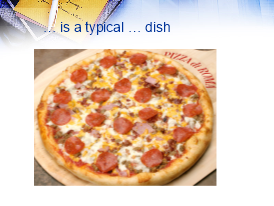
Pizza is a typical Italian dish.
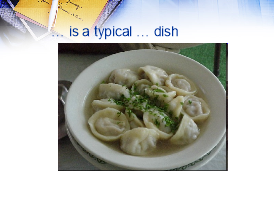
Pelmeni is a typical Russian dish.
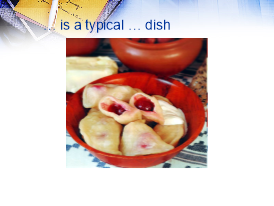
Varenyky is a typical Ukrainian dish.
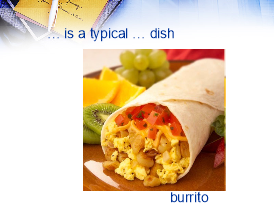
Burrito is a typical Mexican dish.
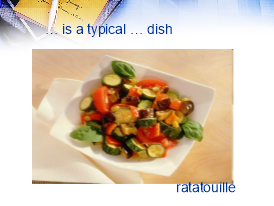
Ratatouille is a typical French dish.
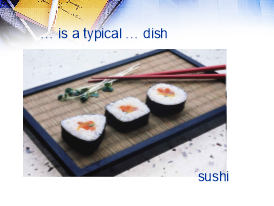
Sushi is a typical Japanese dish.
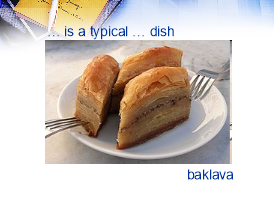
Baklava is a typical Turkish dish.
T: That is great.
3 ) Checking home assignment.
- T: As you know Christmas pudding means very much for British cuisine. Who can tell us about it. (Report about Christmas pudding)
- T: A lot of the British people prefer eating out. You can try the cuisines of almost every country of the world in Britain nowadays.
And your hometask for today was to prepare some information about famous restaurants in London. Let’s listen to some pupils. (Reports about restaurants in London)
We have just learnt about some restaurants.
What are their names?
What food are served in each of them?
Would you like to visit restaurants with the traditional food of other countries?
Food from what country would you like to try?
I think that all of you sometimes visit some restaurants or caf?, where you have a talk with the waiters while you order something to eat or drink. So let’s listen to some dialogues “ In the Restaurants.”
4 ) Listening
Now, let’s listen to the dialogue between the interviewer and George.
Be attentive and then we will do the task ( true or false). If the sentence is false, please, explain why.
- George, why did you decide to open a restaurant in Argentina?
- I’d always wanted to have my own restaurant and it would have been very expensive to do that in England.
- What kind of food do you serve?
- Mainly international dishes like pasta. Steak and fries, risotto – but we also do several English dishes as well.
- Were Argentinian people surprised when they heard that an English chef was going to open a restaurant here?
- Yes, they were – very! I think people do not usually expect the English to be good cooks.
- Is your chef English?
- No, he is Argentinian – but I have taught him to make some English dishes.
- What kind of English dishes do you have on your menu?
- Well, we are open in the morning, and we serve traditional English breakfast, and then we have a lot of English desserts at lunchtime, for example, trifle – that is typical English dessert made with fruit and cake and cream. And we do proper English teas in the afternoon – tea with cakes and sandwiches.
- Are the English dishes popular?
- Yes, especially the desserts and cakes. I think people here in Argentina have a very sweet tooth.
- And finally is there any English food that you really miss here?
- The thing I miss most living in Argentina is English cheese. I really miss Stilton – which is a wonderful English blue cheese. It is not as famous as some of the French cheese like Roquefort but I think it should be. You should try it.
- I will try! Thank you for the interview.
- Welcome to the restaurant!
True or false.
1 George opened up a restaurant in Canada.
2 They mainly serve international dishes.
3 George thinks everybody knows the English to be excellent cooks.
4 The chef of the restaurant is Argentinian.
5 They have traditional English breakfast and typical English desserts on the menu.
6 English dishes are not much popular in Argentina.
7 George misses a wonderful French cheese – Roquefort.
8 Stilton is English blue cheese.
5) Now it is time for break.
T : Offer you to play a funny game. It is a game of questions. You must be honest when you answer the questions. If your answer is never- your mark will be 1; if you say sometimes- 2; often- 3; always- 4.
Here you are the questions:
1. Do you shout “Mum, I don’t want to eat my breakfast?”
2. Do you wash your hands badly and then wipe off the dirt on the clean towel?
3. Do you say of a new dish “I don’t like that”, before you have tasted it?
4. Do you forget to say “please” when you ask for something and “ thank you” when you get it?
5. Do you forget to say “Bon Appetite” to your parents, friends, brothers or sisters at a meal-time?
6. Do you forget to wash up your plate after the meal?
7. Do you say “I don’t want any meat and vegetables, I am not hungry”, and then ask for 2 pieces of cake?
8. Do you buy food in the street and eat it there when you know that your hands are dirty?
9. Do you help your mother to cook dishes?
10. Do you eat late at night or when all the members of your family don’t see you?
The results
If you score is 0-11: you are perfect if you didn’t lie. There are only few such people in the world;
If you score is 12-21: you are a polite child:
If you score is 22-30: sometimes it is dangerous to stay with you;
If you score is 31-40: people who surround you are in danger. I am sorry for your parents and for you too.
6) Розвиток навичок усного мовлення
T: That’s enough. It’s high time to go to the restaurant or to the cafe. Do you often go there? Look at the menus and guess where they come from
1. a pizzeria 3. a fast- food restaurant
2.a business-class flight 4. a British pub
Menu 1 Menu 2
Hungarian goulash with rice Appetisers Spaghetti carbonara Main course Cod, chips and peas Chicken stuffed with ricolla Roast lamb with roast potatoes, cheese served with ratatouille
peas and carrots salmon and tuna bake served Chicken curry and rice with bechamel sauce
Cheeseburger, chips and salad Dessert
Vegetarian terrine made with goat's cheese White chocolate mousse with
and aubergines orange segments
A range of wines, minerals and
spirits are
Range of sandwiches and salads available from the bar
PLEASE PAY FOR YOUR FOOD
WHEN YOU ORDER AT THE BAR.
7) Matching
T: Match the dishes with the appropriate ingredients
1. Hungarian goulash is made with
2. Ratatouille is made with
3. Ratafia is made from
4. Pasta is made from
5. A seafood cocktail is served with
6. Hamburgers are often served with
a) a mayonnaise dressing
b) beef and vegetables
c) almonds
d) tomatoes and lettuce
e) flour, eggs and water
f) red peppers, aubergines and courgettes
8) Group Work
T: Watch a video and write what the British eat for breakfast, lunch and dinner
9) Grammar Practice.
T: As I have said at the beginning of the lesson we have got some grammar exercises. It is the 2- d Conditional. Tell me, please, when do we use the 2-d Conditional? How do we form it?
And now let’s do some exercises.


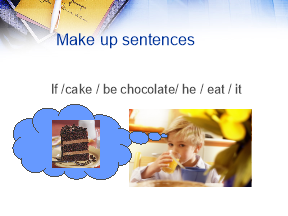

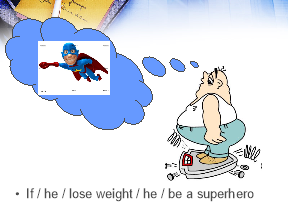
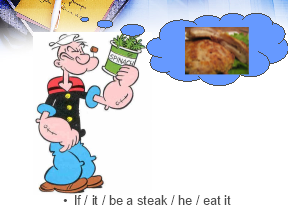
You have got some cards on your desk. Your task is to complete the sentences by changing the verbs in brackets to make 2-d Conditional.
1 If I (be) in Bukovyna, I (help) myself to brynza.
2 If I (have) some dried fruit, I (make) uzvar or kysil.
3 I (can make) kvas if I (have) some dried bread.
4 If you (be) in Poltava, you (be invited) to taste Ukrainian borshch with halushky.
5 If you (ask) me what dessert I would like to have, I (mention) about apple pie first.
10) Speeking
T : What you can tell about the Ukrainian food? ( Слайд укр. блюд )
P1. Ukrainians enjoy a variety of traditional cookery. Breakfast, lunch, dinner, supper. Breakfast is a simple meal of bread and butter. Lunch may consists of a fish dish, a salad or vegetables. Dinner is the main meal.
P2. The traditional Ukrainian food includes hot borsch, kasha, mlyntsi, pyrohy and varenyky.
P3. The ingredients of hot borsch are;
-Beef consommé
- Tomato sauce
-Shredded cabbage
-Shredded carrols
- Sliced potatoes
- Sliced onions
- Beets cut into their stripes
- Dill
- Sour cream
- Sail and pepper to taste
P4. Another food is kasha. You may put eggs, butter, salt into it. It will be tasty.
P5. As for me I Like mlyntsi best of all. I make it of wheat flour, yeast, sugar, salt, milk, butter, eggs, sour cream.
P6. My mother cooks pyrohy every weekend. She takes flour, salt, sour cream, eggs, yeast.
P7. As for varenyky all the members of our family enjoy eating them. We like them with curds and potatoes. We eat piroshky, holubtsi, pampushky and when it is hot in summer we drink kvas.
T : You’ll just told much interesting about Ukrainian food.
11) Reading
We know that Ukrainian cuisine is very varied and Ukrainians are famed for their hospitality. Ukraine like other countries has its own national cuisine. Now look at the screen. You can see our national dishes. Your task was to find some information about these dishes.( borshch, varenyky, holubtsi, deruny, kholodets, salo, mlyntsy, domashnia kovbasa)
- It is brawn made from boiling pigs” trotters. The meat is picked off the born and the gravy sets around it into a jelly as it cools; served with horseradish or mustard
- Pancakes, often made with soured milk for a lighter batter. Thinner pancakes are called nalysnyky, which are rolled and served with a stuffing, usually fruit and jam.
- Cabbage rolls stuffed with rice and vegetables, or possibly with spiced minced meat, and stewed slowly in the oven.
- Soup based on beetroot with meat and other vegetables; served with sour cream. There are many regional varieties.
- Pork fat – no description of Ukrainian cuisine would be complete without it. Ukrainians like their pigs to be fat for it. Spices are rubbed into the skin. It is eaten in thin slices on black bread with garlic and salt. Especially delicious is the smoked version.
- Ravioli – like pasts stuffed with potato, cabbage, mushrooms, meat or cheese, or with cherries as a sweet dish.
- A domestic sausage, but it can not be called saliami. The only way to sample true home – prepared sausage is by experiencing it for yourself with the sights and smells of the markets of Ukraine.
- Pancakes made from grated potato and flour and fried; served with sour cream.
12) Listening
T: Look at the screen and watch a video about cooking a famous Ukrainian dish. It is borshch.
Then you will have to put the sentences in the correct order.
1. Put some oil into the pan and fried onion and beetroot
2. Add carrots and potatoes.
3. Take meat and vegetables.
4. Add some cabbage.
5. Add fried onions and beetroot
6. Put some sour cream and parsley.
7. Cut vegetables.
8. Add some salt.
9. Put meat into the water and boil 15 min.
10. Cut some meat into small pieces.
III Summing up the lesson
T : You have been working hard today.
Your hometask for the next lesson is
* Write about the restaurant you have been to. Describe the interior and the
food you ate there.
* What was the service like? Would you recommend your friend to visit this
restaurant?
T : The lesson is over. You are free.
-
-
very good lesson !
-
Thanks a lot for sharing.


про публікацію авторської розробки
Додати розробку
